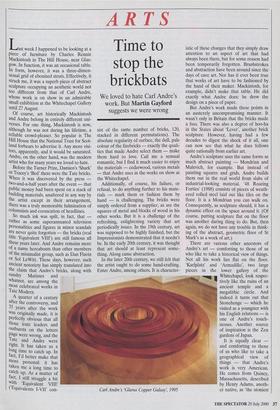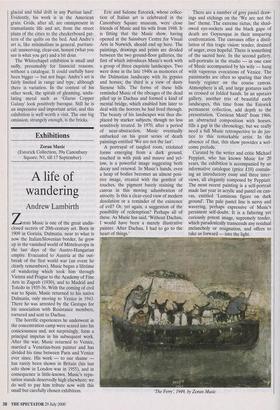ARTS
Time to stop the brickbats
Last week I happened to be looking at a piece of furniture by Charles Rennie Mackintosh in The Hill House, near Glas- gow. In function, it was an occasional table. In form, however, it was a three-dimen- sional grid of ebonised struts. Effectively, it struck me, it was a superb piece of abstract sculpture occupying an aesthetic world not too different from that of Carl Andre, whose work is on show in an admirable small exhibition at the Whitechapel Gallery until 27 August.
Of course, art historically Mackintosh and Andre belong in entirely different uni- verses. For one thing, Mackintosh is now, although he was not during his lifetime, a reliable crowd-pleaser. So popular is The Hill House that the National Trust for Scot- land forbears to advertise it. Any more visi- tors, apparently, and it would be saturated. Andre, on the other hand, was the modern artist who for many years we loved to hate. Before the Turner Prize, Damien's 'Shark' or Tracey's 'Bed' there were the Tate bricks. When it was discovered by the press — two-and-a-half years after the event — that public money had been spent on a stack of building materials, unaltered in any way by the artist except in their arrangement, there was a truly memorable fulmination of columnists and coruscation of headlines.
So much ink was spilt, in fact, that rather as some superannuated television personalities and figures in minor scandals are never quite forgotten — the bricks (real title 'Equivalent VIII') are still famous all these years later. And Andre remains more of a name hereabouts than other members of the minimalist group, such as Dan Flavin or Sol LeWitt. These days, however, such ancient notoriety has simply translated into the claim that Andre's bricks, along with sundry Matisses and whatnot, are among the most celebrated works in Tate Modern.
A quarter of a century after the controversy, and 35 years after the work was originally made, it is Perfectly obvious that all those irate leaders and outbursts on the letters page were wrong, and the Tate and Andre were right. It has taken us a long time to catch up. In fact, I'd better make that more personal: it has taken me a long time to catch up. As a matter of fact, I still struggle a bit with 'Equivalent VIII' ( Equivalents I-VIP con- sist of the same number of bricks, 120, stacked in different permutations). The absolute regularity of surface, the dull, pale colour of the firebricks — exactly the quali- ties that made Andre select them — make them hard to love. Call me a sensual romantic, but I find it much easier to enjoy the materials — cedarwood, various metals — that Andre uses in the works on show at the Whitechapel.
Additionally, of course, his failure, or refusal, to do anything further to his mate- rials — mark them or fashion them by hand — is challenging. The bricks were simply ordered from a supplier, as are the squares of metal and blocks of wood in his other works. But it is a challenge of the refreshing, enlightening variety that art periodically issues. In the 19th century, art was supposed to be highly finished, but the Impressionists demonstrated that it needn't be. In the early 20th century, it was thought that art should at least represent some- thing. Along came abstraction.
In the later 20th century, we still felt that the artist ought to do some hand-crafting. Enter Andre, among others. It is character- - Carl Andre's 'Glarus Copper Galaxy, 1995 istic of these changes that they simply draw attention to an aspect of art that had always been there, but for some reason had been temporarily forgotten. Brushstrokes and abstraction have been around since the days of cave art. Nor has it ever been true that works of art have to be fashioned by the hand of their maker. Mackintosh, for example, didn't make that table. He did exactly what Andre does: he drew the design on a piece of paper.
But Andre's work made these points in an austerely uncompromising manner. It wasn't only in Britain that the bricks made a fuss. There was also a degree of hoo-ha in the States about 'Lever', another brick sculpture. However, having had a few decades to digest the shock of it all, one can now see that what he does follows quite rationally from earlier art.
Andre's sculpture uses the same forms as much abstract painting — Mondrian and Malevich, for example. But instead of painting squares and grids, Andre builds them out in the real world from slabs of industrial-looking material. '48 Roaring Forties' (1988) consists of pieces of weath- ered rolled steel laid out like tiles on the floor. It is a Mondrian you can walk on. Consequently, as sculpture should, it has a dynamic effect on the space around it. (Of course, putting sculpture flat on the floor was another daring thing to do. But, then again, we do not have any trouble in think- ing of the abstract, geometric floor of St Mark's as a work of art.) There are various other ancestors of Andre's art — comforting to those of us who like to take a historical view of things. Not all his work lies flat on the floor. `Karlplatz' and 'Armadillo', two large pieces in the lower gallery of the Whitechapel, look respec- ' -7 tively like the ruins of an ancient temple and a megalithic circle. And indeed it turns out that Stonehenge — which he visited as a youngster with his English relations — is one of Andre's touch- stones. Another source of inspiration is the Zen gardens of Japan.
It is equally clear — and comforting to those of us who like to take a geographical view of things — that Andre's work is very American. He comes from Quincy, Massachusetts, described by Henry Adams, anoth- er native, as 'the stoniest glacial and tidal drift in any Puritan land'. Evidently, his work is in the American grain. Grids, after all, are omnipresent in transatlantic life and art, from the street plans of the cities to the checkerboard pat- tern of the quilts on the bed. And Andre's art is, like minimalism in general, puritani- cal: unswerving, clear-cut, honest (what you see is what you get) and a bit dour.
The Whitechapel exhibition is small and sadly, presumably for financial reasons, without a catalogue. It could usefully have been bigger — but not huge. Andre's art is fairly limited in range and type, although there is variation. In the context of his other work, the spirals of gleaming, undu- lating metal such as 'Glarus Copper Galaxy' look positively baroque. Still he is an impressive and important artist, and this exhibition is well worth a visit. The one big omission, strangely enough, is the bricks.



























































 Previous page
Previous page